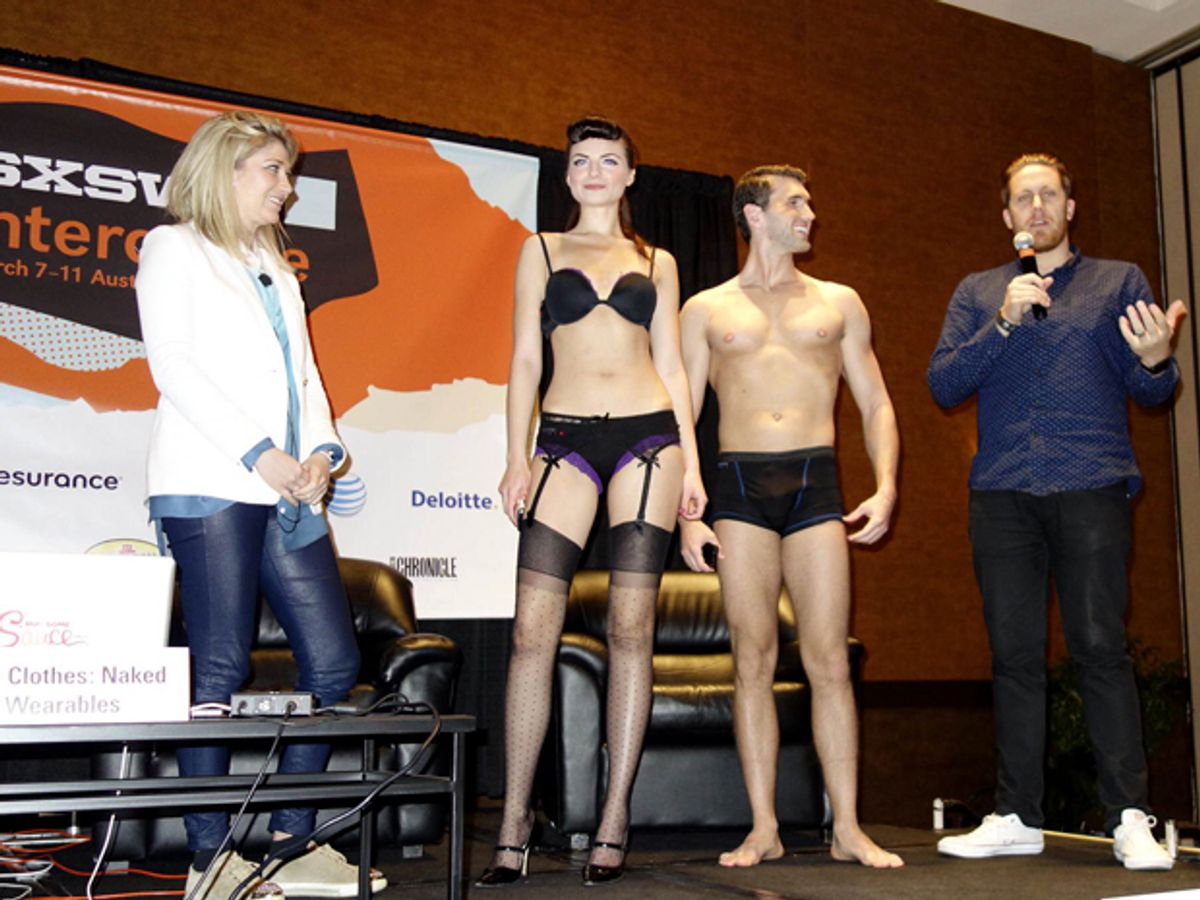So, maybe you’ve bought a Nike+ Fuelband or a Jawbone UP band. Maybe it’s still on your wrist, and you check its data compulsively. But maybe it’s in a drawer, with your clunky smartwatch, your portable HD radio, and your Microsoft Zune.
Or maybe you are an early adherent of Google Glass, stoically enduring the discomfort and occasional aggression of friends, relatives, passersby, and drunk, enraged bar patrons. On the other hand, perhaps, like app developer Q Manning, you’ve concluded sadly that Google Glass is “great for texting and that’s about it.”
“I don’t think wearable technology has found its niche,” Manning added during a panel session Monday at the SXSW Interactive conference. “We all know we want it, but we don’t know what we want it to do yet. We’re all waiting for someone to solve that problem, but, unfortunately, Steve [Jobs] is gone.”
Manning’s co-panelists certainly had a few ideas, though, and one of them was vividly demonstrated by a pair of statuesque models who took the stage in technologically advanced and yet attractive underwear, prompting a blizzard of camera flashes. The demonstration came as close as could be reasonably expected to fulfilling the promise of the session’s title: “Tech Off Your Clothes: Naked Truths Of Wearables.”
The underwear were prototypes developed in a project called “Fundawear,” explained panelist Jay Morgan of the marketing firm Havas Worldwide. Havas had been hired by the UK-based manufacturer Durex, which was eager to associate its brand more with innovation. Though it offers an extensive line of personal massagers, for example, Durex is generally recognized only as a maker of condoms.
Havas was charged with coming up with a splashy innovation for Durex, and their brainstorming soon centered on the question, “can we do something for [lovers] when they are not together? Can you actually touch someone over the Internet?”
This proposal led to what can only be called a milestone in human civilization: the first ever electrically-engineered underwear. Fundawear was designed by another of the SXSW panelists, Billie Whitehouse, whose firm is called Wearable Experiments. The prototype Fundawear samples are close-fitting black undergarments equipped with tiny haptic electromagnetic vibrators, which produce a momentary sensation much like piezoelectric-based units used to create the quick vibration in a smartphone when a key is touched. The units are strategically installed in the garments—in the female version, in both brassiere and panties—to make contact with sensitive regions of the body. When the wearer’s partner touches his or her smartphone—the sensitive regions are helpfully indicated on a template on the phone’s screen—the wearer feels a gentle frisson, or even a light stroke, depending on whether the partner has touched or swiped the screen.
The engineering challenges were nontrivial, Morgan explained. First, they wanted to create the sensation of a lover’s gentle touch, and finding a technology that could reliably and safely produce that feeling—and be laundered—wasn’t easy. “There was some great work in electroactive polymers at the University of Auckland,” Morgan explained. “We contacted them and they said, ‘where are you going to stick this stuff?’ And we said, ‘down in your pants.’ They said, ‘Oh, that’s probably not a good idea,’” noting that the polymers operate at 4500 volts.
Another challenge was making instantaneous contact, no matter how far apart the partners were. An app pairs the wearer’s smartphone to his or her garment, using WiFi (Bluetooth would be used if Fundawear is put into production, Morgan said). But the users’ phones have to communicate with each other securely and instantaneously. The design team solved that one by using Amazon Web Services, a cloud scheme, to convey the data between phones. Each partner has a secret key to assure security, Morgan added.
Eugenia and Stephen, the models who wore Fundawear at the SXSW session, were delighted with it. “It’s a very light vibration, like a touch,” said Eugenia. “It depends on how you touch,” she said. “If you slide, it’s like a stroke.” The two did not know each other prior to the SXSW assignment, and they each controlled their own undergarment, Eugenia said. “We didn’t want to be too intimate in this situation,” she explained. (Stephen didn’t have a comment.)
Morgan said executives with Durex’s Global Product Development Team are studying the feasibility of putting the wearables into production. He said a decision could be announced in the next several months.
Wearable Experiments’ Whitehouse demonstrated another possible direction for wearables at the session. She was wearing her Navigate Jacket, which pairs to a smartphone app and gives gentle and appropriately timed taps on the left or right shoulder to guide the wearer to a destination.
Asked about the future of the jacket, Whitehouse replied, possibly with tongue slightly in cheek, “The future of this jacket, for me, is inductive-charging coathangers.”
Later in the session, when asked about what people, particularly older people, really want in wearable electronics, she said: “My mother, in particular, just wants a device that repels all other technology. That doesn’t let people track her, or contact her.”
Glenn Zorpette is editorial director for content development at IEEE Spectrum. A Fellow of the IEEE, he holds a bachelor's degree in electrical engineering from Brown University.



